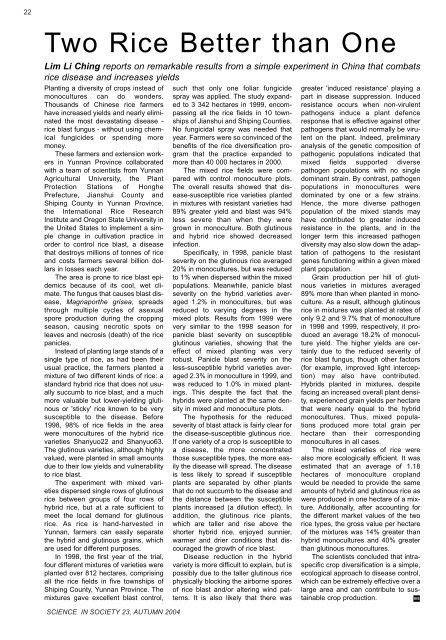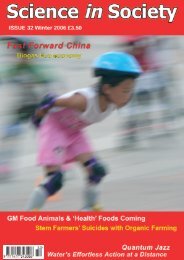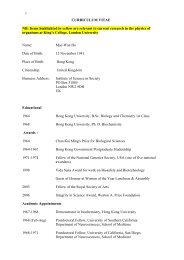Ethiopia goes organic to feed herself - The Institute of Science In ...
Ethiopia goes organic to feed herself - The Institute of Science In ...
Ethiopia goes organic to feed herself - The Institute of Science In ...
You also want an ePaper? Increase the reach of your titles
YUMPU automatically turns print PDFs into web optimized ePapers that Google loves.
22<br />
Two Rice Better than One<br />
Lim Li Ching reports on remarkable results from a simple experiment in China that combats<br />
rice disease and increases yields<br />
Planting a diversity <strong>of</strong> crops instead <strong>of</strong><br />
monocultures can do wonders.<br />
Thousands <strong>of</strong> Chinese rice farmers<br />
have increased yields and nearly eliminated<br />
the most devastating disease -<br />
rice blast fungus - without using chemical<br />
fungicides or spending more<br />
money.<br />
<strong>The</strong>se farmers and extension workers<br />
in Yunnan Province collaborated<br />
with a team <strong>of</strong> scientists from Yunnan<br />
Agricultural University, the Plant<br />
Protection Stations <strong>of</strong> Honghe<br />
Prefecture, Jianshui County and<br />
Shiping County in Yunnan Province,<br />
the <strong>In</strong>ternational Rice Research<br />
<strong><strong>In</strong>stitute</strong> and Oregon State University in<br />
the United States <strong>to</strong> implement a simple<br />
change in cultivation practice in<br />
order <strong>to</strong> control rice blast, a disease<br />
that destroys millions <strong>of</strong> <strong>to</strong>nnes <strong>of</strong> rice<br />
and costs farmers several billion dollars<br />
in losses each year.<br />
<strong>The</strong> area is prone <strong>to</strong> rice blast epidemics<br />
because <strong>of</strong> its cool, wet climate.<br />
<strong>The</strong> fungus that causes blast disease,<br />
Magnaporthe grisea, spreads<br />
through multiple cycles <strong>of</strong> asexual<br />
spore production during the cropping<br />
season, causing necrotic spots on<br />
leaves and necrosis (death) <strong>of</strong> the rice<br />
panicles.<br />
<strong>In</strong>stead <strong>of</strong> planting large stands <strong>of</strong> a<br />
single type <strong>of</strong> rice, as had been their<br />
usual practice, the farmers planted a<br />
mixture <strong>of</strong> two different kinds <strong>of</strong> rice: a<br />
standard hybrid rice that does not usually<br />
succumb <strong>to</strong> rice blast, and a much<br />
more valuable but lower-yielding glutinous<br />
or 'sticky' rice known <strong>to</strong> be very<br />
susceptible <strong>to</strong> the disease. Before<br />
1998, 98% <strong>of</strong> rice fields in the area<br />
were monocultures <strong>of</strong> the hybrid rice<br />
varieties Shanyuo22 and Shanyuo63.<br />
<strong>The</strong> glutinous varieties, although highly<br />
valued, were planted in small amounts<br />
due <strong>to</strong> their low yields and vulnerability<br />
<strong>to</strong> rice blast.<br />
<strong>The</strong> experiment with mixed varieties<br />
dispersed single rows <strong>of</strong> glutinous<br />
rice between groups <strong>of</strong> four rows <strong>of</strong><br />
hybrid rice, but at a rate sufficient <strong>to</strong><br />
meet the local demand for glutinous<br />
rice. As rice is hand-harvested in<br />
Yunnan, farmers can easily separate<br />
the hybrid and glutinous grains, which<br />
are used for different purposes.<br />
<strong>In</strong> 1998, the first year <strong>of</strong> the trial,<br />
four different mixtures <strong>of</strong> varieties were<br />
planted over 812 hectares, comprising<br />
all the rice fields in five <strong>to</strong>wnships <strong>of</strong><br />
Shiping County, Yunnan Province. <strong>The</strong><br />
mixtures gave excellent blast control,<br />
SCIENCE IN SOCIETY 23, AUTUMN 2004<br />
such that only one foliar fungicide<br />
spray was applied. <strong>The</strong> study expanded<br />
<strong>to</strong> 3 342 hectares in 1999, encompassing<br />
all the rice fields in 10 <strong>to</strong>wnships<br />
<strong>of</strong> Jianshui and Shiping Counties.<br />
No fungicidal spray was needed that<br />
year. Farmers were so convinced <strong>of</strong> the<br />
benefits <strong>of</strong> the rice diversification program<br />
that the practice expanded <strong>to</strong><br />
more than 40 000 hectares in 2000.<br />
<strong>The</strong> mixed rice fields were compared<br />
with control monoculture plots.<br />
<strong>The</strong> overall results showed that disease-susceptible<br />
rice varieties planted<br />
in mixtures with resistant varieties had<br />
89% greater yield and blast was 94%<br />
less severe than when they were<br />
grown in monoculture. Both glutinous<br />
and hybrid rice showed decreased<br />
infection.<br />
Specifically, in 1998, panicle blast<br />
severity on the glutinous rice averaged<br />
20% in monocultures, but was reduced<br />
<strong>to</strong> 1% when dispersed within the mixed<br />
populations. Meanwhile, panicle blast<br />
severity on the hybrid varieties averaged<br />
1.2% in monocultures, but was<br />
reduced <strong>to</strong> varying degrees in the<br />
mixed plots. Results from 1999 were<br />
very similar <strong>to</strong> the 1998 season for<br />
panicle blast severity on susceptible<br />
glutinous varieties, showing that the<br />
effect <strong>of</strong> mixed planting was very<br />
robust. Panicle blast severity on the<br />
less-susceptible hybrid varieties averaged<br />
2.3% in monoculture in 1999, and<br />
was reduced <strong>to</strong> 1.0% in mixed plantings.<br />
This despite the fact that the<br />
hybrids were planted at the same density<br />
in mixed and monoculture plots.<br />
<strong>The</strong> hypothesis for the reduced<br />
severity <strong>of</strong> blast attack is fairly clear for<br />
the disease-susceptible glutinous rice.<br />
If one variety <strong>of</strong> a crop is susceptible <strong>to</strong><br />
a disease, the more concentrated<br />
those susceptible types, the more easily<br />
the disease will spread. <strong>The</strong> disease<br />
is less likely <strong>to</strong> spread if susceptible<br />
plants are separated by other plants<br />
that do not succumb <strong>to</strong> the disease and<br />
the distance between the susceptible<br />
plants increased (a dilution effect). <strong>In</strong><br />
addition, the glutinous rice plants,<br />
which are taller and rise above the<br />
shorter hybrid rice, enjoyed sunnier,<br />
warmer and drier conditions that discouraged<br />
the growth <strong>of</strong> rice blast.<br />
Disease reduction in the hybrid<br />
variety is more difficult <strong>to</strong> explain, but is<br />
possibly due <strong>to</strong> the taller glutinous rice<br />
physically blocking the airborne spores<br />
<strong>of</strong> rice blast and/or altering wind patterns.<br />
It is also likely that there was<br />
greater 'induced resistance' playing a<br />
part in disease suppression. <strong>In</strong>duced<br />
resistance occurs when non-virulent<br />
pathogens induce a plant defence<br />
response that is effective against other<br />
pathogens that would normally be virulent<br />
on the plant. <strong>In</strong>deed, preliminary<br />
analysis <strong>of</strong> the genetic composition <strong>of</strong><br />
pathogenic populations indicated that<br />
mixed fields supported diverse<br />
pathogen populations with no single<br />
dominant strain. By contrast, pathogen<br />
populations in monocultures were<br />
dominated by one or a few strains.<br />
Hence, the more diverse pathogen<br />
population <strong>of</strong> the mixed stands may<br />
have contributed <strong>to</strong> greater induced<br />
resistance in the plants, and in the<br />
longer term this increased pathogen<br />
diversity may also slow down the adaptation<br />
<strong>of</strong> pathogens <strong>to</strong> the resistant<br />
genes functioning within a given mixed<br />
plant population.<br />
Grain production per hill <strong>of</strong> glutinous<br />
varieties in mixtures averaged<br />
89% more than when planted in monoculture.<br />
As a result, although glutinous<br />
rice in mixtures was planted at rates <strong>of</strong><br />
only 9.2 and 9.7% that <strong>of</strong> monoculture<br />
in 1998 and 1999, respectively, it produced<br />
an average 18.2% <strong>of</strong> monoculture<br />
yield. <strong>The</strong> higher yields are certainly<br />
due <strong>to</strong> the reduced severity <strong>of</strong><br />
rice blast fungus, though other fac<strong>to</strong>rs<br />
(for example, improved light interception)<br />
may also have contributed.<br />
Hybrids planted in mixtures, despite<br />
facing an increased overall plant density,<br />
experienced grain yields per hectare<br />
that were nearly equal <strong>to</strong> the hybrid<br />
monocultures. Thus, mixed populations<br />
produced more <strong>to</strong>tal grain per<br />
hectare than their corresponding<br />
monocultures in all cases.<br />
<strong>The</strong> mixed varieties <strong>of</strong> rice were<br />
also more ecologically efficient. It was<br />
estimated that an average <strong>of</strong> 1.18<br />
hectares <strong>of</strong> monoculture cropland<br />
would be needed <strong>to</strong> provide the same<br />
amounts <strong>of</strong> hybrid and glutinous rice as<br />
were produced in one hectare <strong>of</strong> a mixture.<br />
Additionally, after accounting for<br />
the different market values <strong>of</strong> the two<br />
rice types, the gross value per hectare<br />
<strong>of</strong> the mixtures was 14% greater than<br />
hybrid monocultures and 40% greater<br />
than glutinous monocultures.<br />
<strong>The</strong> scientists concluded that intraspecific<br />
crop diversification is a simple,<br />
ecological approach <strong>to</strong> disease control,<br />
which can be extremely effective over a<br />
large area and can contribute <strong>to</strong> sustainable<br />
crop production.<br />
SiS











